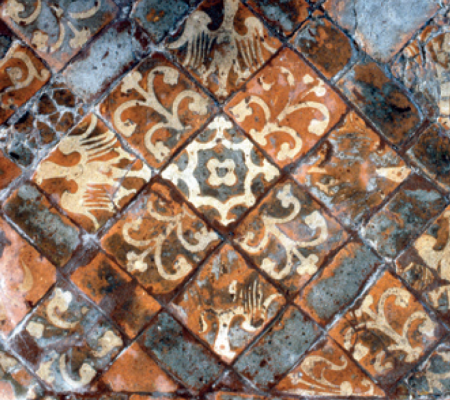Encaustic tiles

|
Encaustic tiles are glazed and decorated earthenware tiles which were produced in huge quantities during the Gothic period between the 13th and 16th centuries and subsequently in 19th century Britain.
Encaustic tiles are earthenware decorative products produced by stamping a design in wet clay and then infilling it with liquid clays of different colour. After firing, the finished tile usually comprises two colours but can have incorporate up to six, depending on the design. Because the colour is not surface applied but actually forms part of the tile body, the colours remain as the tile is worn down through use. The effect is analogous to a wood inlay. Typically, the inlay in the tiles can be as shallow as 3mm.
The term encaustic is a Victorian term; they were called inlaid tiles during the medieval period. Traditionally, the tile body was made from a red clay mixed with sand. A design in relief would be carved on a wooden block and pressed into the still-moist clay. The resulting form would then be filled with a white clay (called slip) which turned yellow when fired in a low temperature kiln (425°C). Tile designs would sometimes be complete individually, otherwise they would be designed to be laid in groups of 4 or 16.
During the Gothic Revival period in the 19th century, encaustic tiles were mass produced throughout western Europe. England was the centre of production although some were also made in the US.
During both Gothic and Victorian periods, the main use for encaustic tiles was for church flooring where it formed an attractive and very durable surface. Some were also laid in private homes although these were generally copies of the tiles in churches.
Encaustic tiles are still manufactured today in a two-part moulding process that is similar to the traditional method. The only difference is that the inlaid colours are first poured into a mould which is then set into the body colour.
NB Short Guide, Scottish traditional shopfronts, published, on 18 April 2017 by Historic Environment Scotland, defines encaustic tiles as: ‘Victorian tiles which are inlaid with clay to produce a decorative pattern and found in shop entrance lobbies. Mass produced in the later 19th century by Minton & Co. and became a fashionable flooring for many Victorian buildings.’
[edit] Related articles on Designing Buildings
- Britain's historic paving.
- Chapels of England: buildings of protestant nonconformity.
- Coal holes, pavement lights, kerbs and utilities and wood-block paving.
- Cologne Cathedral.
- Floors of the great medieval churches.
- Floorscape in art and design.
- Palace of Westminster.
- St Pauls Cathedral.
- St. Basil's Cathedral.
IHBC NewsBlog
Old Sarum fire in listed (& disputed) WW1 Hangar - Wiltshire Council has sought legal advice after fire engulfed a listed First World War hangar that was embroiled in a lengthy planning dispute.
UK Antarctic Heritage Trust launches ‘Virtual Visit’ website area
The Trust calls on people to 'Immerse yourself in our heritage – Making Antarctica Accessible'
Southend Council pledge to force Kursaal owners to maintain building
The Council has pledged to use ‘every tool in the toolbox’ if urgent repairs are not carried out.
HE’s Research Magazine publishes a major study of the heritage of England’s suburbs
The article traces the long evolution of an internal programme to research 200 years of suburban growth
IHBC Context 183 Wellbeing and Heritage published
The issue explores issues at the intersection of heritage and wellbeing.
SAVE celebrates 50 years of campaigning 1975-2025
SAVE Britain’s Heritage has announced events across the country to celebrate bringing new life to remarkable buildings.
IHBC Annual School 2025 - Shrewsbury 12-14 June
Themed Heritage in Context – Value: Plan: Change, join in-person or online.
200th Anniversary Celebration of the Modern Railway Planned
The Stockton & Darlington Railway opened on September 27, 1825.
Competence Framework Launched for Sustainability in the Built Environment
The Construction Industry Council (CIC) and the Edge have jointly published the framework.
Historic England Launches Wellbeing Strategy for Heritage
Whether through visiting, volunteering, learning or creative practice, engaging with heritage can strengthen confidence, resilience, hope and social connections.













